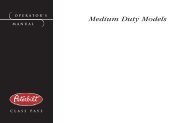MODEL 330 OPERATOR'S MANUAL - Peterbilt Motors Company
MODEL 330 OPERATOR'S MANUAL - Peterbilt Motors Company
MODEL 330 OPERATOR'S MANUAL - Peterbilt Motors Company
Create successful ePaper yourself
Turn your PDF publications into a flip-book with our unique Google optimized e-Paper software.
Start–Up<br />
3. Fuel Filter/Water Separator Draining—check and drain.<br />
Depending on the fuel storage facility, more frequent<br />
draining may be required.<br />
4. Windshield washer reservoir fluid level—fill if necessary.<br />
5. Hood closed before entering cab. Is it latched properly?<br />
Chassis and Cab Checks — Daily<br />
Before entering the cab and operating the vehicle, check the<br />
following equipment for proper maintenance:<br />
1. Lights—do headlights, turn signals, emergency flashers,<br />
and exterior lamps function and are they clean and<br />
adjusted properly?<br />
2. Windows and Mirrors—are they clean and adjusted<br />
properly?<br />
3. Tires and Wheels—are they inflated properly? Are all<br />
wheel cap nuts in place and torqued properly—tighten if<br />
necessary. Check front wheel bearing oil levels. Inspect<br />
all tires and wheels for damage—correct if found.<br />
4. Suspension—check for loose or missing fasteners.<br />
Check damage to springs or other suspension parts.<br />
5. Brake Components—check lines, linkages, chambers,<br />
and brake operation.<br />
Operating Instructions<br />
6. If your truck has hydraulic brakes, check:<br />
• the brake system for leaks<br />
• hydraulic lines for cracks or kinks<br />
• calipers for leaks<br />
7. Air System—are there leaks?<br />
• Air Tanks—drain water from all air tanks. Make sure<br />
the drain cocks are closed. This procedure is also<br />
required for air suspension tanks equipped with<br />
automatic drain valves.<br />
• See page 70 for further details on “Using the Brake<br />
System.”<br />
8. Steps and Handholds—check for worn surfaces and<br />
loose or missing fasteners.<br />
9. Fluid Tanks—check underneath the vehicle for signs of<br />
fluid leaks. If any are found, correct before operating the<br />
vehicle.<br />
10. Fuel Tank Caps—are they secure?<br />
WARNING! Diesel fuel in the presence of an ignition<br />
source (such as a cigarette) could cause an<br />
explosion. You could be seriously injured. A<br />
mixture of gasoline or alcohol with diesel fuel<br />
increases this risk of explosion.<br />
• Do not remove a fuel tank cap near an open<br />
flame.<br />
• Use only the fuel and/or additives recommended<br />
for your engine.<br />
– 14 – PB1318 3/01 Model <strong>330</strong>
















